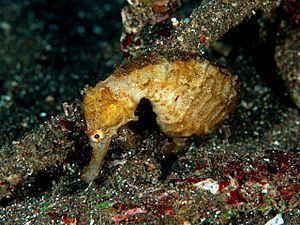Flat-faced seahorse facts for kids
Quick facts for kids Flat-faced seahorse |
|
|---|---|
 |
|
| Conservation status | |
| Scientific classification | |
| Synonyms | |
|
The flat-faced seahorse is also known by other names like the longnose seahorse or three-spot seahorse. Its scientific name is Hippocampus trimaculatus. This special fish belongs to the Syngnathidae family, which also includes pipefishes.
You can find the flat-faced seahorse in many places. It lives in the shallow seas around Australia, Japan, India, Indonesia, and other parts of Asia. These seahorses are currently listed as "vulnerable." This means they need protection because their natural homes are being lost.
Contents
About the Flat-faced Seahorse
The flat-faced seahorse lives mainly in shallow seas. It is found near Australia and many countries in Asia. This seahorse eats tiny creatures like plankton and small crustaceans. It sucks them up with its long snout.
When eating, this seahorse often holds onto sea grass. This helps it save energy, which is a common seahorse behavior. Their look can change a lot. They usually have a flat face with a sharp, hook-like cheek. They also have small spines near their eyes.
Their head is narrow, and they don't have spines on their nose. Their color can be golden orange, sandy, or even completely black. Some flat-faced seahorses even have brown and white stripes, like a zebra! Male seahorses are usually a bit longer than females.
Where They Live and Why They Are Vulnerable
Flat-faced seahorses usually live in waters that are 10 to 100 meters deep. But sometimes, young seahorses have been seen in very shallow water. This might mean they can travel long distances by floating with ocean currents.
These seahorses like different types of homes. They can be found on gravel or sand bottoms near coral reefs. They also live in muddy river mouths called estuaries. Sometimes, they are found near mangrove trees. They can even live in brackish water, which is a mix of fresh and salt water.
The flat-faced seahorse is considered "vulnerable." This is mainly because their homes are being destroyed. Also, millions of seahorses are caught and traded around the world each year. Flat-faced seahorses are often caught by accident when people are fishing for other things.
Seahorses are used in traditional medicine in some countries. They are also dried and sold as souvenirs. Many are sold as pets too. Because of this, an organization called CITES (Convention on International Trade in Endangered Species of Wild Fauna and Flora) has suggested rules for trading seahorses. These rules are not always strict, but traders try to follow them to show they are being responsible. One important rule is that seahorses shorter than 10 centimeters should not be caught.
How Flat-faced Seahorses Reproduce
The 10-centimeter size rule is important for seahorses. This is because their size, not their age, often shows when they are ready to have babies. For example, seahorses in the South China Sea and North China Sea become mature at the same size. But those in the South China Sea are only 3 months old, while those in the North China Sea are 5 months old.
Flat-faced seahorses usually become mature before they reach 10 centimeters. However, some other seahorse species grow larger than 10 centimeters before they are ready to reproduce. This means the rule might need to be looked at again for those species.
When flat-faced seahorses mate, the female gives her eggs to the male. The male then carries the eggs in a special pouch. He gives birth to live baby seahorses. The time it takes for the babies to develop is usually about 16 days. This time can change based on the water temperature. For example, it takes 19 days in cooler water (22.5 °C) and only 11 days in warmer water (28.5 °C).
In captivity, flat-faced seahorses can reproduce all year. But in the wild, like in the China Sea, they have the most babies from March to May. Their peak breeding time can be different in other places. This is because they reproduce best when the water temperature stays steady.
Genetics of the Flat-faced Seahorse
Scientists have found that flat-faced seahorses are divided into two main groups. These groups live on different sides of an invisible line in Indonesia called Wallace's Line. One study looked at seahorses used for medicine or souvenirs. They found that all these seahorses came from the group on the Asian side of Wallace's Line. More studies are needed to see if one group is more at risk than the other.
Another study in 2004 found something interesting. Even though some seahorses were collected only 800 kilometers apart in Southeast Asia, their genes were very different. But, the same study also found seahorses with almost identical genes that were collected up to 10,000 kilometers apart along the Asian coast. This suggests that these seahorses have traveled and mixed their genes over long distances for thousands of years.
See also
 In Spanish: Hippocampus trimaculatus para niños
In Spanish: Hippocampus trimaculatus para niños


